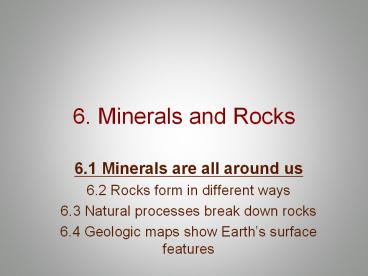6. Minerals and Rocks PowerPoint PPT Presentation
Title: 6. Minerals and Rocks
1
6. Minerals and Rocks
- 6.1 Minerals are all around us
- 6.2 Rocks form in different ways
- 6.3 Natural processes break down rocks
- 6.4 Geologic maps show Earths surface features
2
6.1 Minerals are all around us
- Before, you learned
- Earth is made of layers
- Earths outermost rocky layer is the crust
- Now, you will learn
- About the characteristics of minerals
- How minerals are classified into groups
- Which mineral group in most common
3
Warm-up Questions
- Latitude is a distance in degrees ________ or
_________ of the _________ - (T/F) Relief maps use contour lines to show
features - Geographic information systems display data in
_____ to build maps
4
Minerals and rocks are part of daily life
- Wires carrying eletric current are made of copper
a mineral! - Table salt (halite) a mineral!
- The Earths crust is made of rocks almost all
rocks are made of minerals!
5
Minerals
- Minerals are not the same as rocks
- A rock has only two of the characteristics
- Solid and forms in nature
- A rock usually has two or more types of minerals
- Minerals are always made up of the same materials
in the same proportions - Quartz crystal has 2 Oxygen atoms for every
silicon atom
6
Minerals
- A mineral is (generally) an inorganic, naturally
occurring, organized crystalline structure
composed of a single chemical compound or
element. - A rock is (generally) a natural solid composed of
multiple crystals of one or more minerals - Although many rocks contain visible crystals of
individual minerals, a rock itself does not have
an overall crystalline structure.
7
Minerals have four characteristics
" A naturally occurring, inorganic material of
constant chemical composition and a definite
crystalline structure."
- 1. Form in nature
- 2. Are solids
- 3. Have a definite chemical makeup
- 4. Have a crystal structure
- Examples copper in the wires that carry
electricity, table salt (halite) - Is water a mineral? Is ice?
- Can minerals be found in rocks?
8
Minerals 1. Formed in Nature
- Can be formed by processes that do not
necessarily involve living organisms - A few minerals can be produced by organisms as
part of shells or bones - Haline forms when water evaporates in a hot
shallow part of the ocean - Granite forms when molten
- rock cools
9
Minerals 2. Solids
- Definite volume and a rigid shape
- Volume amount of space an object takes up
10
Minerals 3. Definite Chemical Makeup
- Specific combination of atoms of certain elements
- Element a substance that contains only one type
of atom - Atom is the smallest particle an element can be
divided into - Most minerals contains more than one element
compounds elements in specific proportions
11
Halite NaCl
Copper - Cu
12
Minerals 4. Have a Crystal Structure
- Crystal solid in which the atoms are arranged in
an orderly, repeating 3-D pattern - Two minerals can have the same chemical
composition but different crystal structures
http//www.classzone.com/books/ml_sci_ca6/page_bui
ld.cfm?idresour_ch2u223
13
- Diamond and graphite are both made of Carbon
- The individual atoms have the same properties,
but are in different arrangement giving the
substance very different properties different
crystal structure
14
Minerals are grouped according to composition
- Grouped on the basis of chemical makeups
- Most common group is silicates
- Contain oxygen silicon most common in Earths
crust joined together - Rock-forming minerals
- The 30 minerals that make up most of the crust
- Silicates make up 90 of the rocks in the crust
- Quartz, feldspare, and mica
- 2nd most common Carbonates (carbon and oxygen) -
calcite
15
Rocks are made of minerals
- Minerals
- must have the four previously mentioned
characteristics - Always made of the same elements in the same
proportions, have an orderly crystal structure - A rock only has two of the four
- It is a solid and forms naturally
- Rocks are usually made of two or more minerals
- The proportion of different minerals in a certain
type of rock may vary - The minerals in a rock can be all jumbled
together - Only a few types of rocks are made of only one
type of mineral - Ex limestone (calcite)
- A few contain no minerals at all
- Ex obsidian (made of natural glass no crystal
structure) - Ex Coal (remains of ancient plants)
16
Math in Science
- Each mineral makes up a certain proportion, or
fraction, of a granite sample - You can compare mineral amounts by expressing
each minerals fraction as a percentage - To change a fraction to a percentage, you must
find an equivalent fraction with 100 as the
denominator - 1/5 to percent?
- First, divide 100 by the denominator 5 20
- Then multiply the numerator and denominator by 20
20/100 20
17
Minerals in a Granite Sample
Mineral Fraction of granite sample Percentage of granite
quartz 1/4
feldspar 13/20
mica 3/50
Dark minerals 1/25

